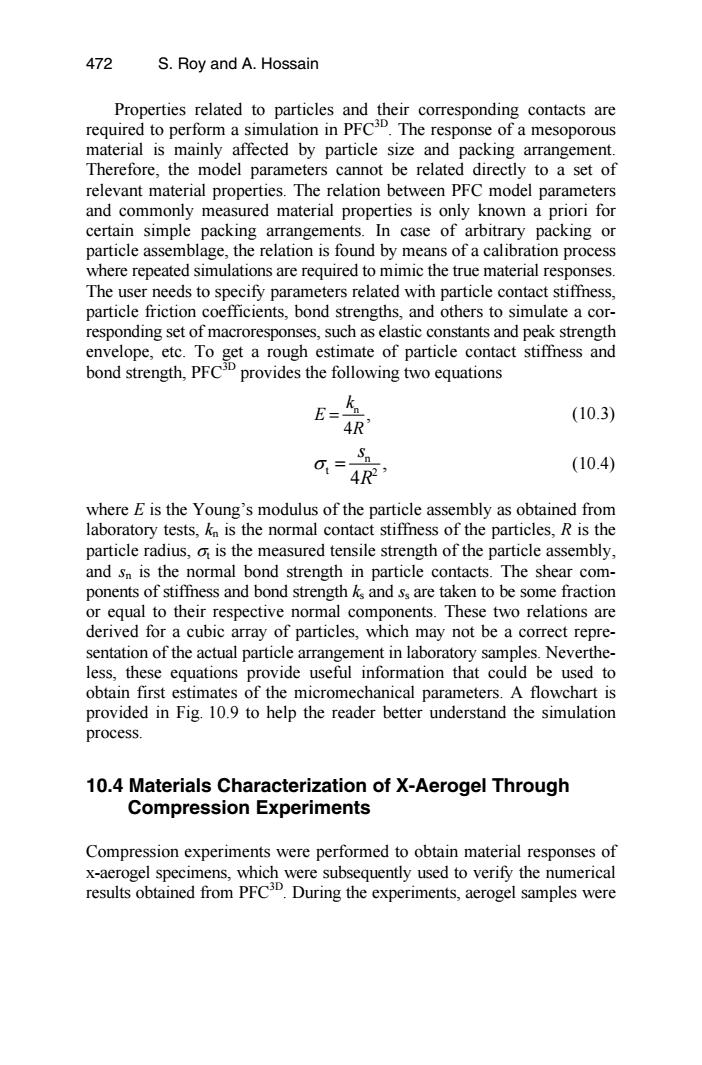正在加载图片...

472 S.Roy and A.Hossain Properties related to particles and their corresponding contacts are required to perform a simulation in PFC3D.The response of a mesoporous material is mainly affected by particle size and packing arrangement. Therefore,the model parameters cannot be related directly to a set of relevant material properties.The relation between PFC model parameters and commonly measured material properties is only known a priori for certain simple packing arrangements.In case of arbitrary packing or particle assemblage,the relation is found by means of a calibration process where repeated simulations are required to mimic the true material responses. The user needs to specify parameters related with particle contact stiffness, particle friction coefficients,bond strengths,and others to simulate a cor- responding set of macroresponses,such as elastic constants and peak strength envelope,etc.To get a rough estimate of particle contact stiffness and bond strength,PFCprovides the following two equations E=- (10.3) 4R' 0= Sn 4R2 (10.4) where E is the Young's modulus of the particle assembly as obtained from laboratory tests,kn is the normal contact stiffness of the particles,R is the particle radius,o is the measured tensile strength of the particle assembly, and sn is the normal bond strength in particle contacts.The shear com- ponents of stiffness and bond strength ks and ss are taken to be some fraction or equal to their respective normal components.These two relations are derived for a cubic array of particles,which may not be a correct repre- sentation of the actual particle arrangement in laboratory samples.Neverthe- less,these equations provide useful information that could be used to obtain first estimates of the micromechanical parameters.A flowchart is provided in Fig.10.9 to help the reader better understand the simulation process. 10.4 Materials Characterization of X-Aerogel Through Compression Experiments Compression experiments were performed to obtain material responses of x-aerogel specimens,which were subsequently used to verify the numerical results obtained from PFC3D.During the experiments,aerogel samples wereProperties related to particles and their corresponding contacts are required to perform a simulation in PFC3D. The response of a mesoporous material is mainly affected by particle size and packing arrangement. Therefore, the model parameters cannot be related directly to a set of relevant material properties. The relation between PFC model parameters and commonly measured material properties is only known a priori for certain simple packing arrangements. In case of arbitrary packing or particle assemblage, the relation is found by means of a calibration process where repeated simulations are required to mimic the true material responses. The user needs to specify parameters related with particle contact stiffness, particle friction coefficients, bond strengths, and others to simulate a corresponding set of macroresponses, such as elastic constants and peak strength envelope, etc. To get a rough estimate of particle contact stiffness and bond strength, PFC3D provides the following two equations n , 4 k E R (10.3) = n t 2 , 4 s R σ = (10.4) where E is the Young’s modulus of the particle assembly as obtained from laboratory tests, kn is the normal contact stiffness of the particles, R is the particle radius, σt is the measured tensile strength of the particle assembly, and sn is the normal bond strength in particle contacts. The shear components of stiffness and bond strength ks and ss are taken to be some fraction or equal to their respective normal components. These two relations are derived for a cubic array of particles, which may not be a correct representation of the actual particle arrangement in laboratory samples. Nevertheless, these equations provide useful information that could be used to obtain first estimates of the micromechanical parameters. A flowchart is provided in Fig. 10.9 to help the reader better understand the simulation process. S. Roy and A. Hossain 10.4 Materials Characterization of X-Aerogel Through Compression Experiments Compression experiments were performed to obtain material responses of x-aerogel specimens, which were subsequently used to verify the numerical results obtained from PFC3D. During the experiments, aerogel samples were 472